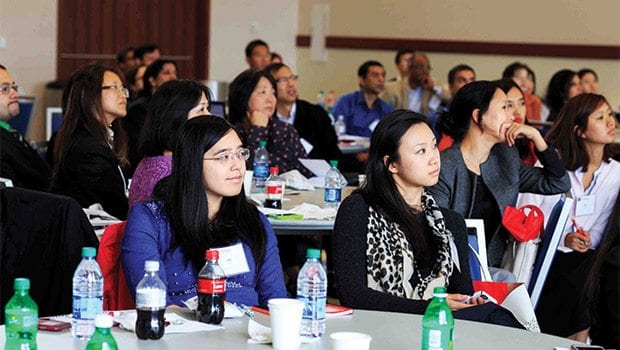Asian women share insights
Asian American group builds women’s support network

Women in the corporate world face many well-documented challenges, but these can be compounded more so for women of color or women that have come to the U.S. from other countries. For this reason, the National Association of Asian American Professionals has made an effort to make sure its women members have specific support that can help them overcome what can sometimes feel like overwhelming odds to success.

Author: Photo: Courtesy of Women in NAAAPMembers of the National Association of Asian American Professionals with Paul Cramer, center, co-lead of the Accenture Negotiations Center for Excellence, who spoke at a workshop last fall.
An important part of the effort is the association’s Women in NAAAP committee, which holds programs, social events and workshops all designed to help Asian American women succeed as professional and personal leaders, as well as influence others in their community and cultures.
This goal fits in line with the work of the overall association — to cultivate, support and promote Asian American professionals through professional development programs, community services engagements and industry connections. The national organization was started in New York in 1982. The Boston chapter was founded in 1992 and is currently one of the largest, with about 450 members. The women membership of the Boston chapter — now over 200 — has been growing, prompting its leaders to pay special attention to the female perspective. The first women’s initiative efforts started about five years ago.
Tiffany Hu, co-director of WIN, as Women in NAAAP is referred to within the organization, said the strength of the women’s program is in connecting the members for support.
“It feels like in Boston there is not that much of an Asian American women community,” said Hu, who came to the United States from China and works at State Street. “We can use WIN as a personal network to inspire each other.”
The social events WIN has held help NAAAP women members connect with each other, but a more guided effort has gone into highlighting women role models and matching experienced businesswomen with young professionals in a mentoring network. Social events have also been organized around giving insight into U.S. culture, such as a wine tasting and a “Sports 101” night.
Workshop topics have included negotiation tactics and health and wellness.
As Hu sees it, women must have the skills, confidence and knowledge to compete in the corporate world and the understanding of how to overcome and challenge perceptions that others may have of them.
One of the programs NAAAP leaders have high hopes for is WIN Lean In Circle, which is just about to get under way for the second year.
Inspired by the best-selling book, “Lean In: Women, Work, and The Will to Lead,” by Sheryl Sandberg, the WIN Lean in Circle is a 12-month program that brings together 8-10 women for monthly meetings to openly talk about the challenges that women face and work together to help each other pursue ambitions and goals.
According to Hu, the discussion alternates between topics from the book or from Sandberg’s Lean In website that supports Lean in Circles. Topics include: team dynamics, difficult conversations, power and influence, lessons learned from failure, and personal branding.
She added that the value of the Lean In Circle is those involved can learn from each other and through others’ experiences with an open exchange.

Author: Photo: Courtesy of Women in NAAAPFemale members of the National Association of Asian American Professionals listen to a presentation about what the organization’s women initiative can do to help them with their professional lives.

Author: Photo: Courtesy of Sheryl SandbergThe National Association of Asian American Professionals Lean In Circle program is inspired by the book “Lean In: Women, Work, and The Will to Lead,” by Sheryl Sandberg.
Mentoring
WIN co-director Eileen Y. Lee Breger, an attorney at Hutchings, Barsamian, Mandelcorn & Robinson, said what is special about the Lean in Circle is that it is a peer-to-peer mentoring group, a sounding board for ideas and a problem solving team.
“On a month-to-month basis they are meeting with other intelligent women with leadership potential to talk about the challenges they face and the success they have,” Lee Breger said. “If you are going through something personally or professional there is a group of women there to support you … It does become a sisterhood and it is a bonding experience.”
The group digs into some serious problems that Asian American women commonly face in climbing the corporate ladder.
Both Hu and Lee Breger give examples of challenges that range from being soft spoken and thus not taken seriously to lacking the confidence to pursue deserved promotions to facing a hostile work environment to lack of partner support at home.
“Everybody at the table has either faced or come across these kind of challenges so you know you are not alone or by yourself,” said Hu. “It is also inspiring because you hear of others who have faced them and are succeeding.”
While the first year of the Lean In Circle program is just wrapping up, the feedback has NAAAP leaders confident that it will be the core component of the WIN initiative for years to come because it has an impact on those who take part.
“Where we have had the most success is building confidence in individuals,” Lee Breger added.
The concept began with a pilot circle of NAAAP female leaders a few years ago — which was so liked that the circle still meets to this day — and then was launched as one circle with association members as a test run over the last year.
The circles will be kept to just 8-10 members on purpose to make it a small and intimate environment. Those that took part in the first circle ranged in age from 25 to 45 from all different industries, a diversity which is valued as a key component and will be maintained as much as possible.
As the Lean In Circle program moves into its second year, the co-directors said they would love to see it continued to evolve with several circles going on at once in the future.
“We want to have more,” Hu said. “People who have graduated from our program can go out and start their own circle. It would be great if they go out and multiply in the community in a grassroots effort.”






